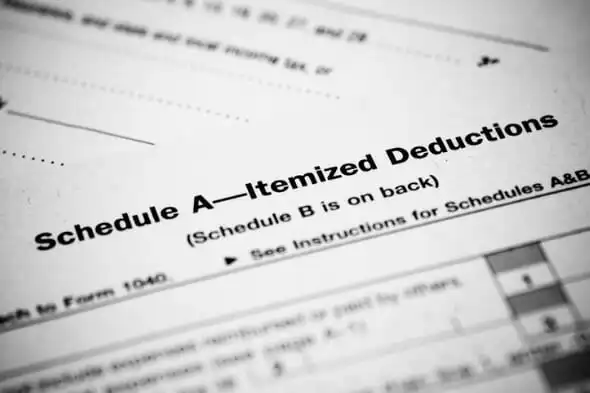President Trump signed the One Big Beautiful Act into law on July 4, making several changes that affect whether taxpayers should itemize deductions starting in 2025. While the standard deduction remains the simpler choice for many, the law raises the SALT deduction cap to $40,000 for joint filers earning up to $500,000 and adds a special rule for pass-through business owners to deduct up to 50% of pass-through entity taxes (PTET) payments. These changes could make itemizing more worthwhile for higher-income households in high-tax states or those with large business-related state tax payments. Most other filers may still benefit more from claiming the higher standard deduction.
A financial advisor can help optimize your long-term tax plan. Speak with an advisor today.
Key Takeaways:
- The One Big Beautiful Act increases the SALT deduction cap to $40,000 for joint filers (with a phase-down above $500,000 income), then goes back down to $10,000 in 2030.
- The new Trump tax law also raises the standard deduction temporarily from 2025 to 2028. Depending on your filing status, you could see an increase of $1,000 to $2,000.
- The seven TCJA tax brackets (10% to 37%) become permanent and adjusted for inflation starting in 2026.
Comparing Standard vs. Itemized Deductions
When you file your taxes, you can either take the standard deduction or itemize deductions—whichever results in lower taxable income. The standard deduction offers a fixed amount based on your filing status, while itemizing lets you deduct certain eligible expenses such as mortgage interest, medical bills and charitable donations.
The TCJA nearly doubled the standard deduction for tax years 2018 through 2025, thereby reducing the need for many taxpayers to itemize deductions. Trump’s plan also capped or limited several itemized deductions, including the state and local tax (SALT) deduction, mortgage interest and medical expenses, while eliminating others like unreimbursed employee expenses.
Here is a breakdown of seven key deductions that changed with the 2017 Trump tax plan:
| Deduction Category | Changes Under 2017 TCJA |
|---|---|
| State and Local Taxes (SALT) | Deduction capped at $10,000 (includes income/sales, real estate and personal property taxes) |
| Mortgage Interest | Cap lowered from $1,000,000 to $750,000 for mortgages after Dec. 15, 2017 |
| Home Equity Loan Interest | No deduction unless funds used to buy, build, or improve the home |
| Charitable Contributions | AGI limit increased from 50% to 60% for cash donations |
| Medical Expenses | Deduction allowed for expenses over 7.5% of AGI (previously 10%) |
| Eliminated Deductions | Unreimbursed employee expenses, tax prep fees, miscellaneous itemized deductions, personal casualty/theft losses (unless federally declared disaster areas) |
| Pease Limitation | Removed; no longer reduces itemized deductions for high-income earners |
These changes led to a sharp drop in the number of taxpayers claiming itemized deductions and reduced the overall tax savings from them. According to the Tax Policy Center, 31% of all individual income tax returns had itemized deductions in 2017. But by 2020, less than two-thirds (only 9%) were still itemizing deductions.
Check out our in-depth study to learn more about how the the One Big Beautiful Bill Act (OBBBA) impacts Americans across the country.
Under the TCJA, the 2025 standard deduction is $15,000 for single filers and those married filing separately, $30,000 for joint filers and $22,500 for heads of household. For a comparison, the 2017 standard deduction before the TCJA was $6,350 for singles and couples filing separately, $12,700 for couples filing jointly and $9,350 for heads of household.
The One Big Beautiful Act increases those amounts through 2028 and then revert to existing levels. Under this legislation, singles and separate filers would get an additional $1,000. Joint filers would have an increase of $2,000, while heads of household would receive $1,500.
Here’s how the TCJA standard deduction compares with the One Big Beautiful Act:
Standard Deduction: 2017 vs. 2025 vs. One Big Beautiful Act
| Filing Status | Pre-TCJA (2017) | TCJA (2025) | One Big Beautiful Act |
|---|---|---|---|
| Single Filers | $6,350 | $15,000 | $16,000 |
| Married Filing Jointly | $12,700 | $30,000 | $32,000 |
| Head of Household | $9,350 | $22,500 | $24,000 |
| Married Filing Separately | $6,350 | $15,000 | $16,000 |
These increases may change whether you can still itemize deductions. For example, if your deductible expenses add up to less than the standard deduction under the new plan, then you would have to take the standard deduction.
What Can You Itemize as a Deduction?
When you itemize deductions, you are listing expenses that will later be subtracted from your adjusted gross income to reduce your taxable income. If your total itemized expenses are higher than your standard deduction, itemizing may result in a lower tax bill.
Not all expenses qualify. The IRS allows certain categories such as:
- Medical and dental expenses (above a threshold)
- State and local taxes, including property and sales tax
- Mortgage interest and loan points
- Investment interest
- Charitable donations
- Tax preparation fees
- Certain unreimbursed employee expenses
- Eligible business expenses
- Casualty, disaster and theft losses
These are known as “below-the-line” deductions because they come after calculating adjusted gross income. In contrast, some deductions—like IRA contributions—can be taken “above-the-line” and don’t require itemizing.
Under the new Trump tax plan, most existing itemized deduction categories remain unchanged. But, the cap on state and local tax (SALT) deductions is temporarily increased. This change could raise the total deductible amount for taxpayers in high-tax states, making itemizing more favorable than the standard deduction.
How the SALT Deduction Cap Affects Itemized Deductions

The One Big Beautiful Act raises the SALT deduction cap to $40,000 for joint filers and $20,000 for married individuals filing separately from 2025 through 2029. This makes itemizing more attractive for households in high-tax states—especially if state and local tax payments exceed the standard deduction.
However, the benefit phases down by 30% for those with income over $500,000 ($250,000 for separate filers). Even with the phase-down, the deduction can’t fall below the TCJA’s $10,000 floor.
Additionally, the bill introduces a separate rule for owners of pass-through entities: they can deduct up to the greater of $40,000 or 50% of their PTET liability, after subtracting other SALT payments. This provision increases the likelihood of itemizing for business owners subject to entity-level state taxes.
Who Should Itemize Deductions in 2025 and Beyond?
Itemizing could benefit taxpayers if total deductions exceed the standard deduction. Itemizing could be more likely for:
- Filers in high-tax states with property and income taxes above the standard deduction
- Taxpayers with mortgage interest, charitable donations, or medical expenses
- Pass-through business owners eligible for the PTET deduction formula
You should note that higher-income taxpayers will see reduced SALT benefits due to the phase-down formula. For many, especially those with fewer deductible expenses, the increased standard deduction may still provide a greater tax benefit than itemizing.
Examples of Standard and Itemized Deductions
Let’s review the table below to help you determine when it makes sense to take the standard deduction or itemize with the higher Trump tax plan SALT deduction cap.
When You Should Itemize: TCJA vs. One Big Beautiful Act
| Example | TCJA (2025) | One Big Beautiful Act |
|---|---|---|
| Standard Deduction | $15,000 for individuals; $30,000 for married couples filing jointly | $16,000 for individuals; $32,000 for married couples filing jointly |
| SALT Deduction Cap | $10,000 | $20,000 for individuals and $40,000 for joint filers (phases down 30% above $250,000/$500,000 MAGI; cannot go below $10,000) |
| Other Itemized Deductions | Mortgage interest, charitable contributions, etc. | Same as TCJA |
| When Itemizing is Beneficial | Total itemized deductions exceed $15,000 (individual) or $30,000 (joint) | Itemized deductions exceed new standard deduction and phase-down does not significantly reduce SALT benefit |
| Impact on High-Income Taxpayers | Limited benefit due to $10,000 SALT cap | SALT deduction reduced for income above $250,000 (individual) or $500,000 (joint), but deduction cannot drop below $10,000 |
| Best for | Filers with large non-SALT deductions | Filers with high SALT and other deductions, below income phase-down thresholds |
As shown above, the One Big Beautiful Act keeps the standard deduction higher than the TCJA—$16,000 for individuals and $32,000 for joint filers starting in 2026. The SALT cap increases to $40,000 for joint filers and $20,000 for individuals from 2025 through 2029, but phases down by 30% of income over $500,000 and $250,000 respectively. Still, the deduction cannot fall below $10,000.
This means more taxpayers may find it beneficial to itemize if they have high state and local taxes, mortgage interest, and other deductions. However, for higher-income taxpayers, the value of itemizing may be reduced due to the phase-down.
Winners and Losers: Itemized Deductions Under the New Trump Tax Plan
The One Big Beautiful Act raises the SALT deduction cap to $40,000 for joint filers and $20,000 for single filers from 2025 through 2029. However, the deduction is reduced by 30% of income over $500,000 (joint) or $250,000 (single) and cannot fall below $10,000. The law also introduces a separate rule for pass-through entity taxes (PTETs), allowing filers to deduct up to the greater of $40,000 or 50% of PTET expenses, after subtracting other SALT amounts.
| Group | One Big Beautiful Act |
|---|---|
| Middle- and upper-middle-income filers in high-tax states | Benefit from $40,000 SALT cap if income is below $500,000 (joint) or $250,000 (single); itemizing becomes more favorable. |
| Joint filers with high SALT and income under $500,000 | Can take full $40,000 SALT deduction if they itemize; reduces taxable income more than TCJA. |
| High-income taxpayers with MAGI above $500,000 | SALT deduction phases down by 30% of income above the threshold; deduction cannot go below $10,000. |
| Pass-through business owners who pay PTETs | May claim higher SALT deduction using PTET formula: greater of $40,000 or 50% of PTETs minus other SALT payments. |
| Residents in low-tax states | Likely no change; total SALT paid often remains under $10,000. |
| Standard deduction users | Unaffected. Most will still use the $16,000 (individual) or $32,000 (joint) standard deduction. |
Bottom Line

Itemizing may still help if your deductions are higher than the standard deduction, which goes up to $16,000 for individuals and $32,000 for joint filers in 2026. The new law raises the SALT cap to $40,000 for joint filers and $20,000 for individuals from 2025 to 2029, with a 30% phase-down for income over $500,000 (joint) or $250,000 (single). The cap won’t go below $10,000. Business owners may deduct more using a separate PTET formula, which allows the greater of $40,000 or 50% of PTETs, minus other SALT deductions.
Tips to Get You Through Tax Season
- A financial advisor with tax expertise can help you at tax time. Finding a financial advisor doesn’t have to be hard. SmartAsset’s free tool matches you with vetted financial advisors who serve your area, and you can have a free introductory call with your advisor matches to decide which one you feel is right for you. If you’re ready to find an advisor who can help you achieve your financial goals, get started now.
- Keeping all of your tax documents organized will help you ace your tax filing. If you choose to itemize, staying organized includes keeping all your receipts. You should keep receipts for at least a few years after you file. It isn’t uncommon for the IRS to also look at returns from three to six years prior to the return they are actually auditing. And depending on which deductions you take, like the home office deduction, your return may be more likely to trigger an audit.
- When you file your taxes, there are quite a few tax filing services to choose from. Two of the most popular, H&R Block and TurboTax both offer a user-friendly design with good explanations of the filing process. Here’s a breakdown to help you decide which service may be better for you.
Photo credits: ©iStock.com/emmgunn, ©iStock.com/izusek, ©iStock.com/PeopleImages
